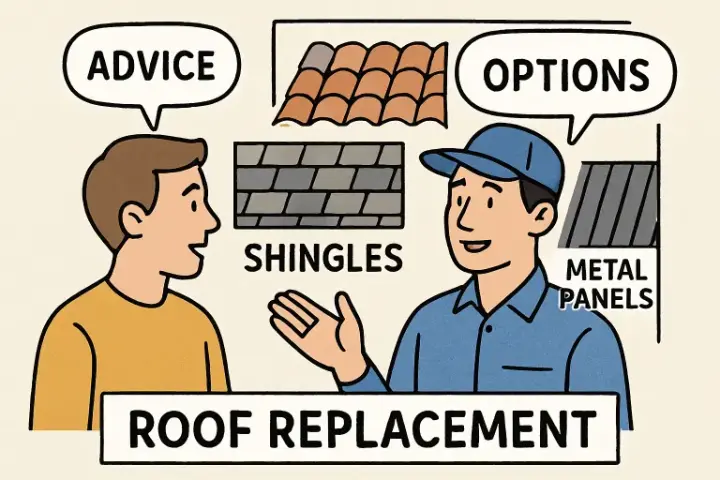When homeowners consider replacing their roof, it's easy to get overwhelmed by misinformation found online or spread by word of mouth. These misconceptions can lead to poorly informed decisions, unexpected expenses, or property damage. Knowing the facts helps you protect your home, maximize your investment, and stay ahead of costly repairs. For reliable guidance and expert craftsmanship on your next project, consider trusted providers such as E.N.G. Roofing roof replacement services Houston to ensure your roof replacement is handled professionally from start to finish.
Myths about roof replacement can cloud judgment, causing homeowners to delay necessary upgrades or tackle unsafe do-it-yourself (DIY) projects. Replacing your roof is a significant investment in your home's longevity and safety, so separating fact from fiction is crucial for making the best choices. With today's advancements in materials, installation techniques, and energy efficiency, understanding the realities of roof replacement can help you avoid stress and save money.
Myth 1: You Only Need to Replace Your Roof When It Leaks
One of the most prevalent misconceptions among homeowners is that roof replacement is only necessary once leaks appear. A leaking roof is often a sign of long-standing, internal damage that could have been identified earlier through regular inspection. Moisture that seeps through the roof can silently erode decking, insulation, and walls—culminating in expensive repairs that extend beyond the roof itself. By scheduling professional inspections every few years, you can catch hidden signs of wear, such as shingle deterioration or flashing damage, before they escalate to major leaks.
Myth 2: Roof Replacement Is a DIY-Friendly Project
Although many home improvements can safely be tackled independently, roof replacement is a complicated and potentially hazardous endeavor that’s best left to licensed professionals. Climbing ladders, handling heavy materials, and working at heights require specialized training and safety measures. Beyond personal risk, improper installation often results in inadequate sealing, trapped moisture, or even structural compromise, which can void manufacturer warranties. Selecting skilled contractors keeps you safe and ensures your new roof meets local building codes and industry best practices. Additional safety-related roofing tips can be found in the Family Handyman.
Myth 3: All Roofing Materials Are the Same
Homeowners often assume that all roofing materials offer similar protection, but this is far from the truth. Asphalt shingles, clay tiles, metal roofing, and composite materials have distinct attributes regarding resilience, appearance, cost, and suitability for various climates. For example, metal roofing works exceptionally well in areas prone to high winds and hail, while clay tiles are ideal in hot, dry climates. Consulting a roofing expert helps you select materials that fit your style and local weather conditions.
Myth 4: A New Roof Doesn't Require Maintenance
A newly installed roof may offer peace of mind but is not invincible. Debris removal, shingle and flashing inspections, and periodic cleaning are necessary to extend the life of your roofing investment. Proactive care prevents moss and algae buildup, tracks minor storm damage, and stops leaks before they start. Most roofing warranties require proof of ongoing maintenance to remain valid, so regular upkeep ensures coverage in case unexpected issues arise. For more on the link between routine checks and home value retention, see Forbes Home.

Myth 5: Roof Replacement Is Prohibitively Expensive
The perception that roof replacement is always unaffordable keeps many homeowners from acting when needed. While total costs depend on size, material quality, labor, and pitch, financing and budget-friendly packages from reputable contractors can make a new roof accessible. Getting multiple quotes and clarifying what each covers materials, labor, permits empowers you to make informed decisions based on your financial situation. In many cases, spreading the cost over several years via payment plans or home improvement loans eases the burden and protects against more expensive repairs.
Myth 6: You Can Install New Shingles Over Old Ones
Installing new shingles over existing, worn ones sounds like a shortcut, but it can backfire in the long run. This practice, known as "reroofing," traps moisture between the layers, potentially leading to wood rot, mold, and reduced shingle life. The underlying deck and supports can't be inspected appropriately or repaired. Most professional roofers recommend stripping the old shingles to ensure a watertight seal and optimal performance for the new roofing system.
Myth 7: Dark-Colored Roofs Make Homes Significantly Hotter
Dark colors absorb more sunlight, but the impact on indoor temperatures isn't as dramatic as believed. Current roofing technologies—including reflective and “cool” shingles, insulation upgrades, and advanced attic ventilation—mitigate much of the potential heat transfer. Proper ventilation and energy-efficient materials can help maintain comfortable indoor temperatures regardless of roof color, reducing energy usage during peak seasons.
Myth 8: Metal Roofs Attract Lightning
Worries that metal roofs increase the risk of lightning strikes stem from misunderstandings about electricity. Metal is no more likely than other roofing materials to be struck. Should lightning hit your home, however, metal disperses the energy efficiently. Because it’s non-combustible, it’s less likely to catch fire—making it a safer option for storm-prone areas. For an in-depth review of lightning and roofing safety, see National Geographic.
Empowering yourself with accurate information about roofing ensures the investment in your home is sound, lasting, and adds real value. Routine inspections, careful material selection, and seeking qualified professionals like E.N.G. Roofing make roof replacement manageable. Don't let popular myths cloud your judgment—trust the facts for peace of mind and long-term home protection.
Roof Replacement Myths Debunked